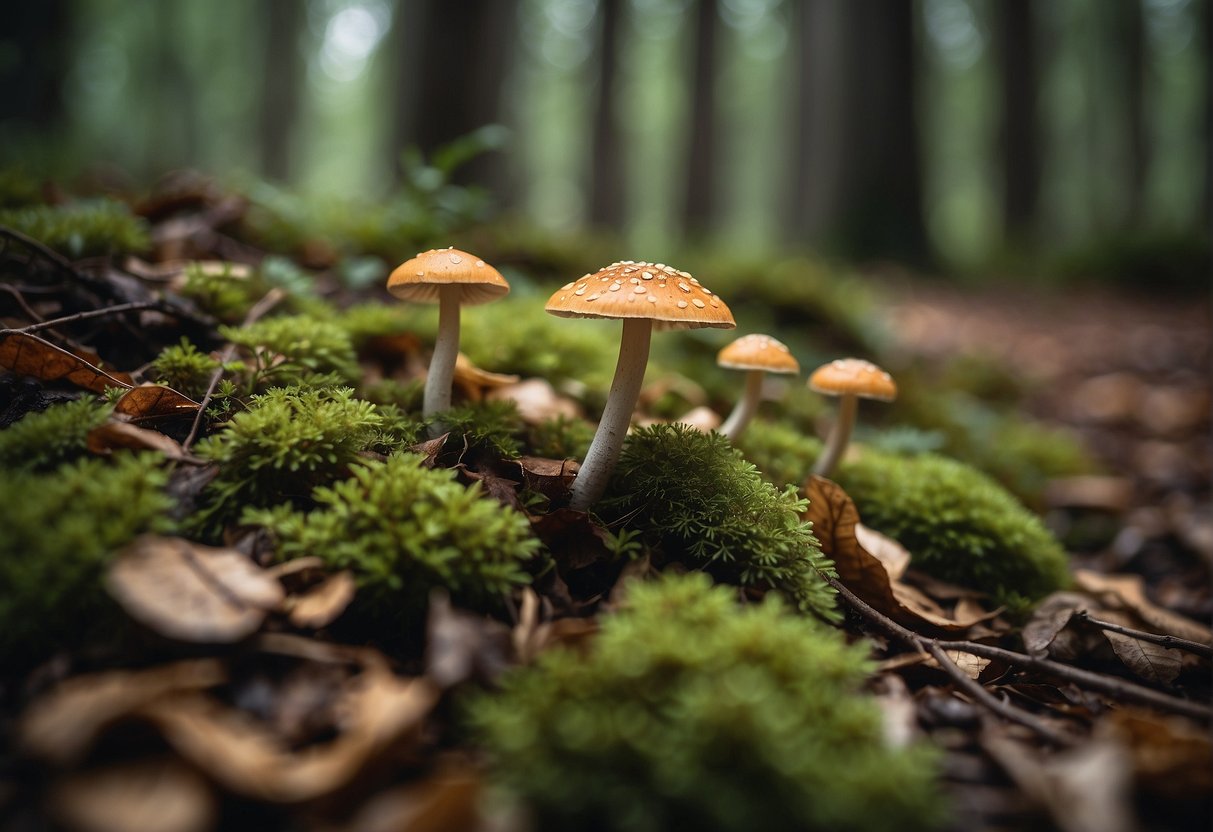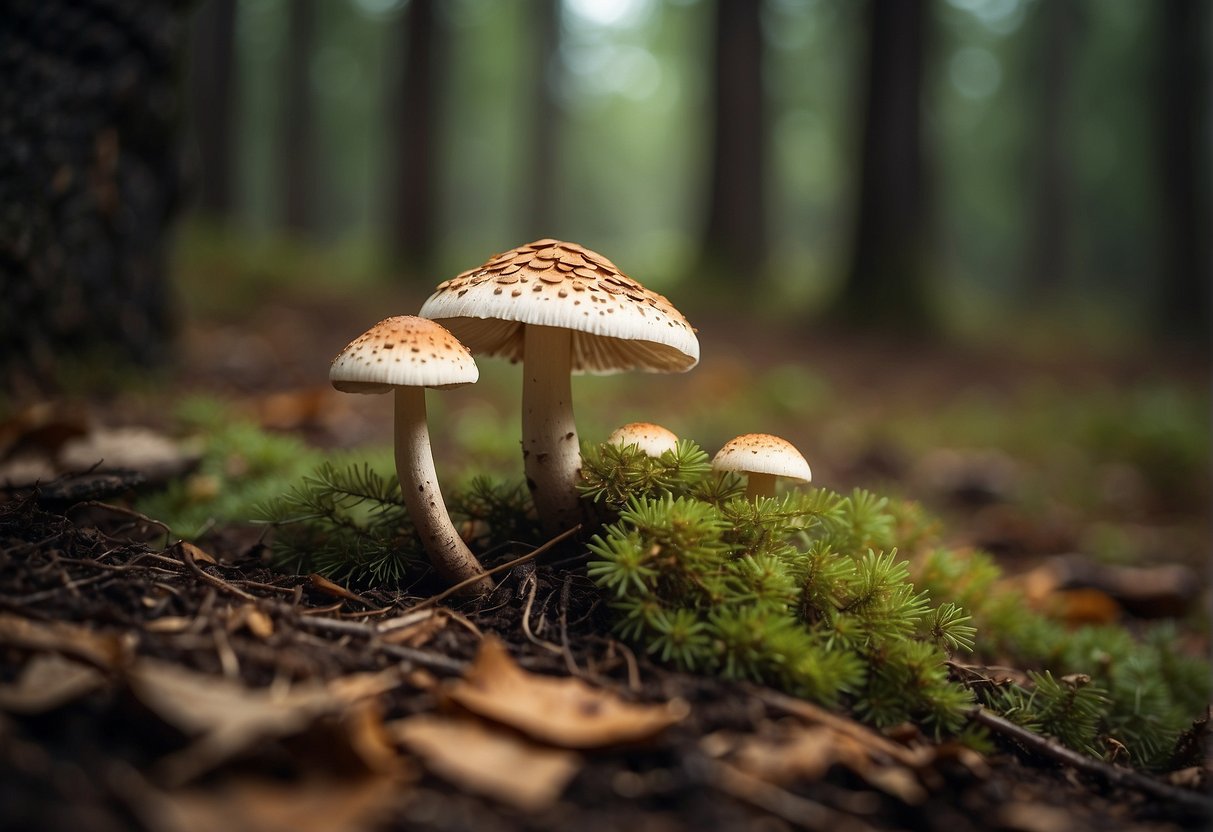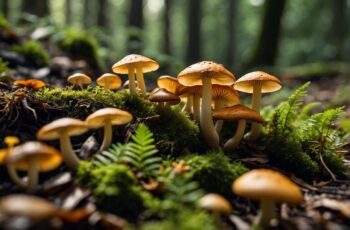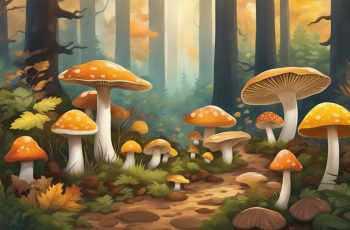Matsutake mushrooms, or Tricholoma matsutake, hold a special place among foragers and chefs alike in Canada and across the Pacific Northwest. Your quest for these elusive mushrooms can take you deep into the conifer forests, where they form a symbiotic relationship with certain types of trees. The matsutake mushroom is a treasure hidden beneath the forest floor, often concealed by a layer of pine needles and leaves, making the hunt for them both challenging and exciting. They are revered for their distinct spicy aroma and their unique flavor that adds depth to many culinary dishes.

In Canada, the season for matsutake mushrooms typically begins in late summer and extends into the fall, with the Pacific Northwest providing some of the best foraging grounds in North America. The rich, moist soil and specific climate conditions in this region create an ideal environment for matsutake mushrooms to thrive. Harvesting these mushrooms is an art, as careful foraging practices are essential to preserve their delicate ecosystems. Moreover, these fungi can significantly influence both local and international economies due to their high value, particularly in Asian markets where they are prized for their culinary and cultural significance.
Key Takeaways
- Matsutake mushrooms are prized for their unique flavor and aroma in Canada.
- They require specific forest ecosystems and careful harvesting practices.
- Matsutake’s high economic value impacts local and international markets.
Matsutake Mushroom Identification

Identifying matsutake, also known as pine mushrooms, is a gratifying skill you can develop with attention to some key characteristics.
Physical Characteristics
Matsutake mushrooms have a distinctive appearance. Caps are cream to brown, reaching up to 20 cm in diameter, and they maintain a convex shape with age. The gills are white, free from the stem, and remain covered by a veil in immature specimens. Stems are thick and can be up to 15 cm tall, featuring a dense structure.
Mycorrhizal Relationships
Matsutake mushrooms forge a crucial mycorrhizal relationship with trees, aiding in water and nutrient absorption. They often associate with coniferous hosts, such as pines and firs, and rely on this partnership to thrive.
Similar Species
While pursuing matsutake, be aware of lookalikes such as Amanita smithiana and Tricholoma caligatum. Unlike matsutake, Amanita smithiana typically presents a ring on the stem and can be poisonous. Tricholoma caligatum and Tricholoma nauseosum have similar forms but differ in aroma and habitat preferences.
Harvesting Practices
Before venturing into the forests this fall to harvest matsutake mushrooms, it’s crucial to understand the right techniques and the importance of sustainable practices to protect these valuable ecosystems.
Foraging Techniques
- Finding Matsutake: You’ll typically discover matsutake from September to November, when they emerge in pine forests populated with hemlock and Douglas fir trees.
- Signs of Growth: Look for a characteristic veil beneath the cap and a spicy, cinnamon-like aroma.
- Tools: Use a small knife or mushroom harvesting tool to cut the stem cleanly, which helps preserve the mycelium for future growth.
Sustainable Harvesting
- Picking Limits: Limit your harvest to what you need, ensuring these mushrooms can continue to be a resource for all.
- Ecosystem Health: By not disturbing the surrounding soil and vegetation, you contribute to the health of the forest and the longevity of the mushroom’s habitat.
- Legal Requirements: Always check the regulations of national forests and ensure that your foraging aligns with the rules in places like Southern Ontario, where conservation is a priority.
Economic Influence

The Matsutake mushroom, with its unique pine aroma, stands out as a high-value product in Canadian forests, shaping the economic landscape from pickers to international markets.
Market Demand
The demand for Matsutake, particularly from nations like Japan, Korea, and China, can’t be overstated. It’s not just a mushroom; it’s a cultural icon, especially in Japan where it is used in traditional autumn celebrations. As such, American Matsutake, which includes the variety found in Canada, often referred to as Western Matsutake, finds a welcoming market in Asia. In North America, while still valued, its allure lies more within niche markets and high-end farmers’ markets.
Pricing and Availability
The price of Matsutake mushrooms is not immune to the forces of supply and demand. Factors such as seasonality heavily dictate their availability and, subsequently, their market price. For instance, during the peak growth in early fall, you might find them more affordable. Moreover, pricing varies considerably by region; North America can offer a more abundant supply compared to the high demand and less availability in Asia, significantly impacting the price points. In European markets, the presence is less pronounced, but a burgeoning interest in exotic fungi could signal future growth.
Culinary Uses

Matsutake mushrooms, also known as pine mushrooms, offer a distinct spicy flavor and an inviting fragrance that underlines their value in culinary applications. They’re harvested in Canada and celebrated for imparting a taste of autumn into various dishes. Here’s how you can explore and incorporate this prized fungus into your cooking repertoire.
Traditional Recipes
As an enthusiast of the outdoors and the bountiful harvest it provides, you’ll appreciate the rustic charm of traditional Japanese recipes that showcase matsutake mushrooms. Matsutake Gohan is a classic dish where the mushrooms are sliced and cooked with rice, allowing the grain to absorb the rich aroma and flavors. This dish highlights the essence of the mushroom and is often enjoyed to celebrate the season. To enhance the experience, the mushrooms might be incorporated into a delicate dashi, a staple broth in Japanese cuisine, that further accentuates the matsutake’s earthy notes.
- Ingredients:
- Fresh matsutake mushrooms
- Rice
- Soy sauce
- Dashi broth
- Instructions:
- Clean and slice matsutake mushrooms.
- Prepare the rice and combine with sliced matsutake.
- Cook the mixture with a dash of soy sauce and a pour of dashi until the rice is tender.
Modern Cuisine Applications
Today’s chefs, inspired by the versatility of matsutake mushrooms, have found innovative ways to infuse modern cuisine with their unique flavor profile. Whether you’re cooking fresh matsutake or using dried matsutake for a concentrated taste, these mushrooms provide not only flavor but also a wealth of nutritional benefits, such as protein, fiber, carbohydrates, and essential amino acids. A chef’s tip: embrace the mushroom’s robustness by pairing it with ingredients that won’t overshadow its character. Consider adding sliced matsutake to a creamy pasta or risotto, or for a fresh approach, serve them pickled as an appetizer or a complement to a charcuterie board.
- Serving Suggestions:
- Pair with mild proteins like chicken or fish
- Finish creamy pasta or risotto with thin matsutake slices
- Pickle matsutake as a garnish or appetizer


